The official currency of Dubai is the United Arab Emirates Dirham (AED), which is commonly referred to as the Dubai currency.
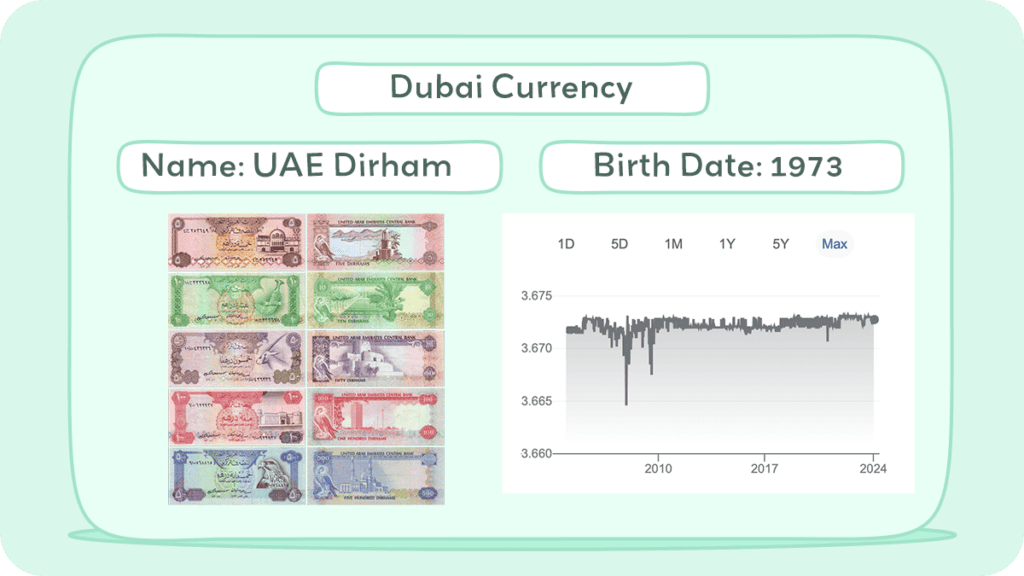
In understanding the AED, it’s important to note that it is divided into smaller units called fils. There are 100 fils in 1 AED, and coins are available in denominations of 1, 5, 10, 25, and 50 fils, as well as 1 AED. Banknotes are available in denominations of 5, 10, 20, 50, 100, 200, 500, and 1,000 AED.
This article will delve into the historical journey of Dubai currency, the history of coins, and the history of bills reflecting the evolution of Dubai’s economy and its transition from a small trading hub to a global financial center. Today, the UAE Dirham is a stable and widely accepted currency that plays a vital role in the country’s economic growth and development.
Historical Journey of Dubai Currency
Dubai’s currency, the UAE Dirham (AED), has come a long way since its introduction in 1973. Over the years, it has undergone several changes and developments to become the stable currency it is today. In this section, we will take a closer look at the historical journey of Dubai currency, the history of coins, and the history of bills.
Before the introduction of the UAE Dirham, Dubai’s currency was the Gulf Rupee, which was issued by the Government of India. With the formation of the UAE in 1971, the Gulf Rupee was replaced by the Qatar and Dubai Riyal, which was used until the introduction of the UAE Dirham in 1973.
History of Coins
In 1973, the United Arab Emirates introduced coins in various denominations, including 1, 5, 10, 25, and 50 fils, as well as 1 dirham. The 1, 5, and 10 fils were made of bronze, while the higher denominations were in cupro-nickel. In 1995, the 5 fils, 10 fils, 50 fils, and 1 dirham coins were resized, and the new 50 fils took on a curve-equilateral-heptagonal shape.
Coins bear Eastern Arabic numerals and Arabic text. The 1, 5, and 10 fils are infrequently used, with amounts typically rounded to the nearest 25 fils. The rare 1 fils coin sees limited circulation, posing a risk of confusion with the similarly sized old 50 fils coin.
Since 1976, the Currency Board of the UAE has minted commemorative coins marking significant events and rulers. Notable is the 25 fils coin featuring a gazelle, the 50 fils with three oil derricks, and the 1 dirham portraying a dallah. All coins display Lunar Hijri and Gregorian years of minting.
History of Bills
The United Arab Emirates (UAE) introduced its first series of banknotes on May 20, 1973, with denominations of 1, 5, 10, 50, and 100 dirhams, followed by a 1,000 dirham note on January 3, 1976. In 1982, a second series was introduced, excluding the 1 dirham and 1,000 dirham notes.
The series was expanded with the addition of 500 dirham notes in 1983 and 200 dirham notes in 1989. The 1,000 dirham notes were reintroduced in 2000. The current banknotes, in circulation, include denominations of 5 (brown), 10 (green), 20 (light blue), 50 (purple), 100 (pink), 200 (green/brown), 500 (navy blue), and 1,000 (greenish blue).
These banknotes feature Arabic text on the obverse with Eastern Arabic numerals, while the reverse includes English text with Arabic numerals. The 200 dirham denomination, initially produced in 1989, was reissued in a different color (yellow/brown) in 2008, replacing the older green/brown version. The 200 dirham note was scarce as it was not regularly circulated; any in circulation today typically comes from bank stocks.
On March 22, 2008, a new 50 dirham note was released, featuring enhanced security features like a color-shifting windowed security thread. On December 7, 2021, a redesigned polymer 50 dirham note was issued to commemorate the UAE’s golden jubilee.
This marked the UAE’s first polymer banknote. Additional polymer banknotes of 5 and 10 dirhams were introduced on April 21, 2022, with the 1,000 dirham polymer note expected in the first half of 2023.
Inflation and Buying Power of United Arab Emirates Dirham

The United Arab Emirates Dirham (AED) is the official currency of Dubai and the United Arab Emirates (UAE). It is abbreviated as AED or DHS. The Central Bank of the UAE is responsible for issuing and managing the currency. The AED is pegged to the US dollar at a rate of 3.67 AED to 1 USD. This means that the exchange rate between the two currencies remains relatively stable.
One of the factors that affect the value of a currency is inflation. Inflation is the rate at which the general level of prices for goods and services is rising, and, subsequently, the purchasing power of currency is falling.
The inflation rate in the UAE has been relatively low in recent years. According to Statista, the inflation rate of the UAE was at 1.93 percent in 2019 compared to the previous year. In 2020 and 2019, there was negative inflation (deflation) with rates of -2.08% and -1.93%, respectively. This indicates a decrease in the general price level during those years.
The low inflation rate in the UAE means that the purchasing power of the AED has remained relatively stable. This is good news for residents and tourists alike, as it means that their money can go further.
For example, if the inflation rate is 2%, then a product that costs 100 AED this year will cost 102 AED next year. However, if the inflation rate is 0%, then the cost of the product will remain the same.
The low inflation rate in the UAE means that the purchasing power of the AED has remained relatively stable. This is good news for residents and tourists alike, as it means that their money can go further.
United Arab Emirates Dirham
If you are traveling to Dubai or any other city in the United Arab Emirates, you will need to familiarize yourself with their currency, the United Arab Emirates Dirham (AED). The Dirham is abbreviated as “د.إ” or “AED” and is commonly referred to as the Emirati Dirham.
The UAE Dirham was introduced in 1973 to replace the Qatar and Dubai Riyal. The value of the Dirham remains stable against the US Dollar, which is the most widely accepted currency for international transactions. The 2021-2023 series features new designs and includes the following.
5 dirhams
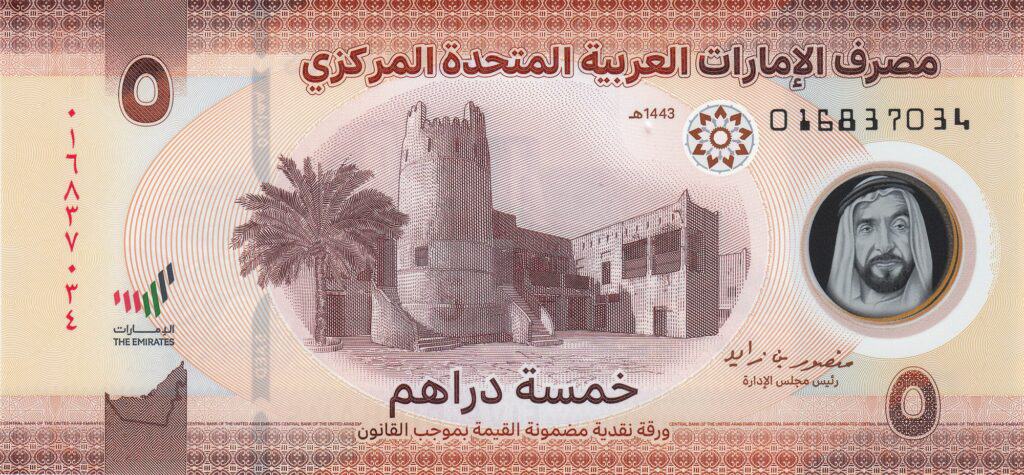
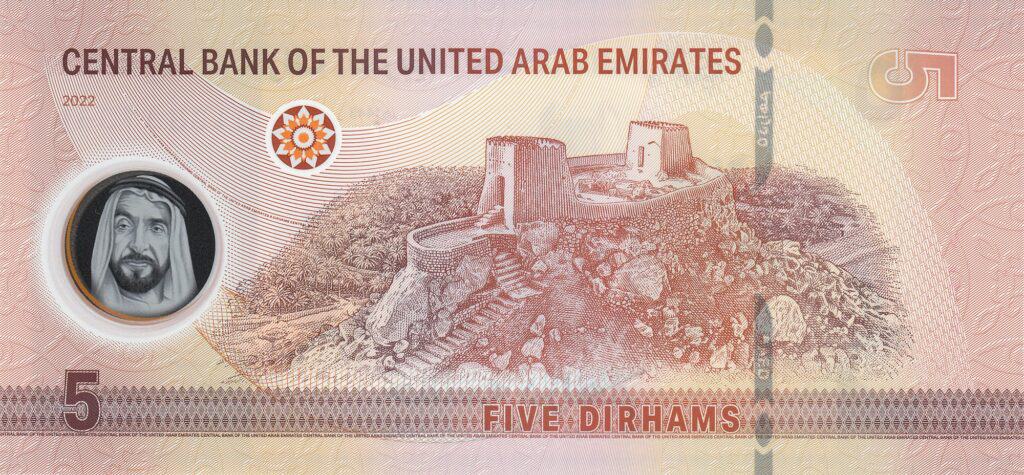
5 dirhams (brown) featuring Ajman fort on the front and Dhayah Fort in Ras al Khaimah on the reverse.
10 dirhams
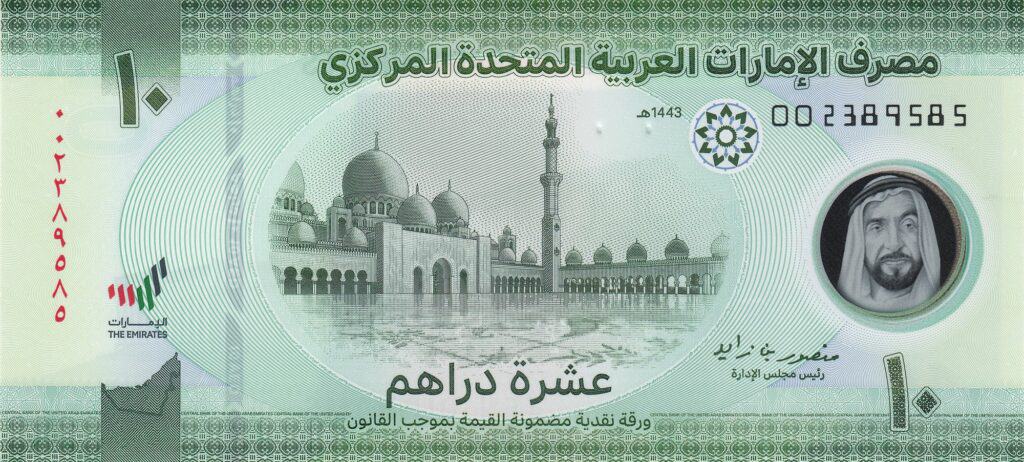
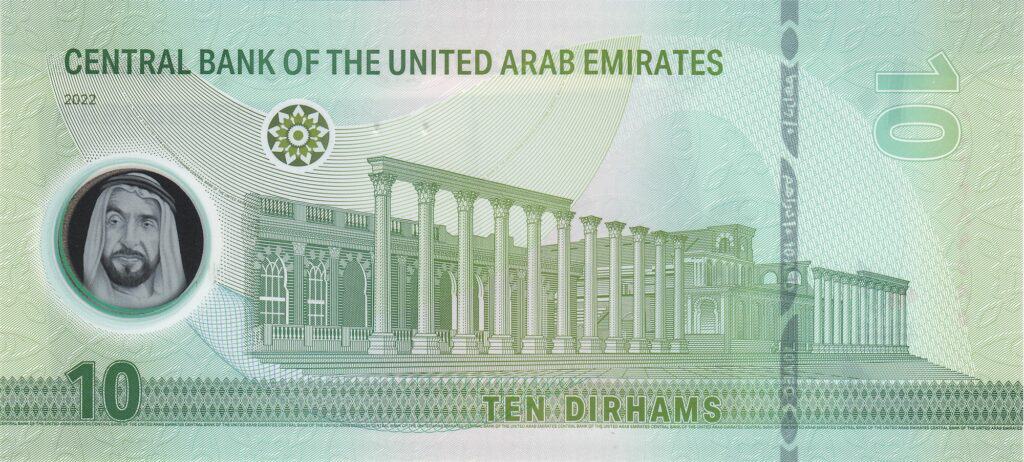
10 dirhams (green) showcasing Sheikh Zayed Grand Mosque on the front and Khor Fakkan Amphitheatre on the reverse.
50 dirhams
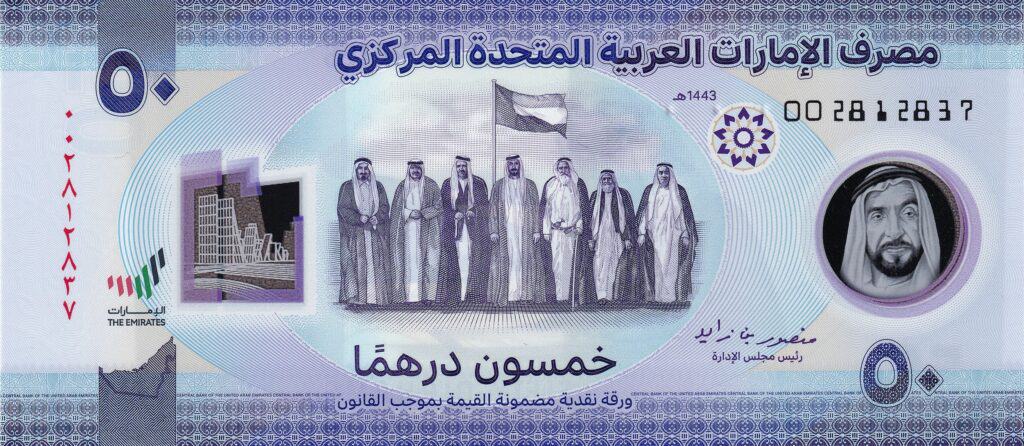
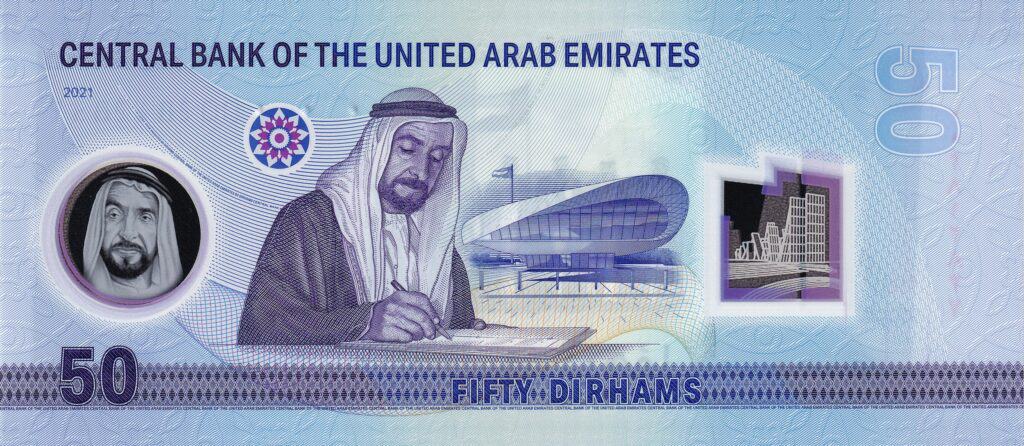
50 dirhams (navy blue) depicting Sheikh Zayed Al Nahyan, the other founding fathers, on the front and Sheikh Zayed signing a union document on the reverse.
100 dirhams
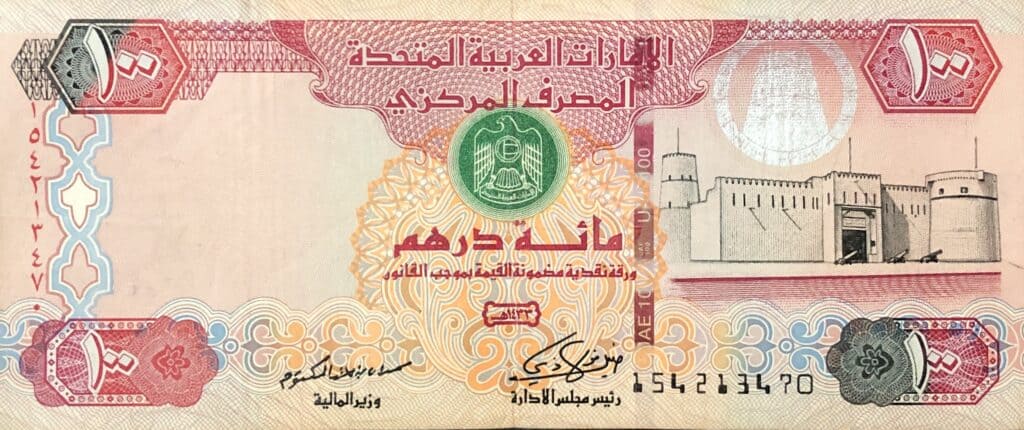
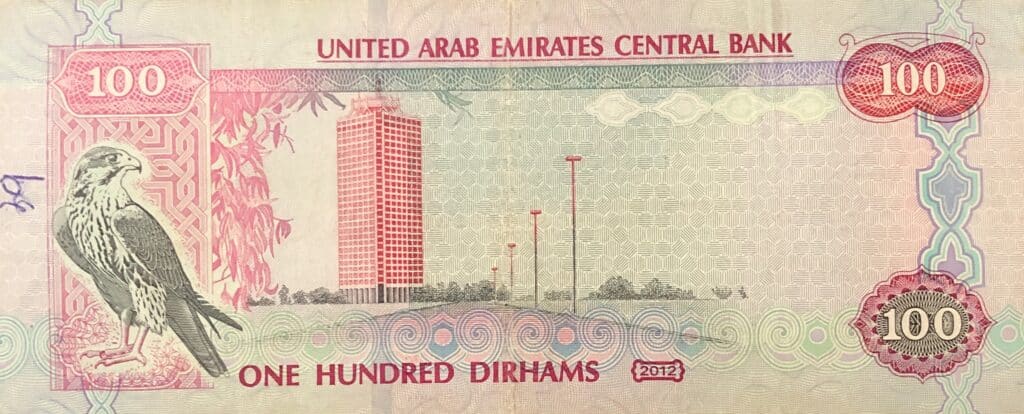
100 dirhams featuring Al Fahidi Fort on the front and Falcon and Dubai World Trade Centre on the reverse.
200 dirhams
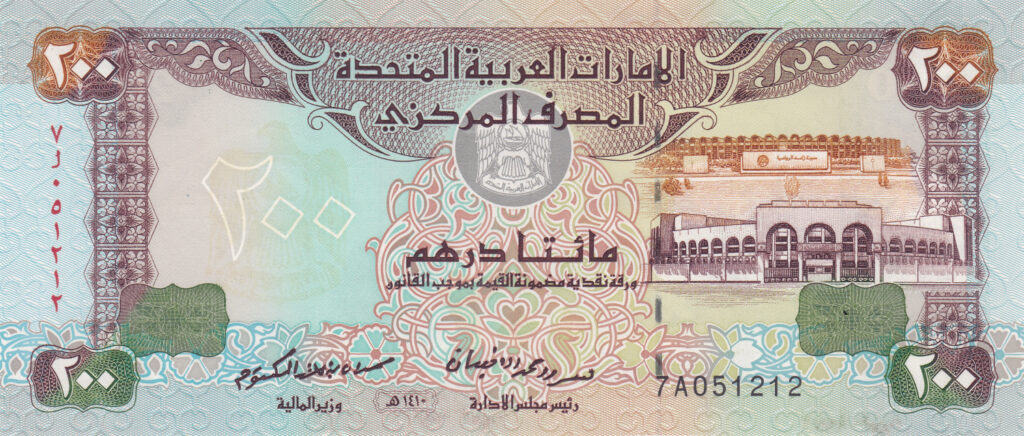
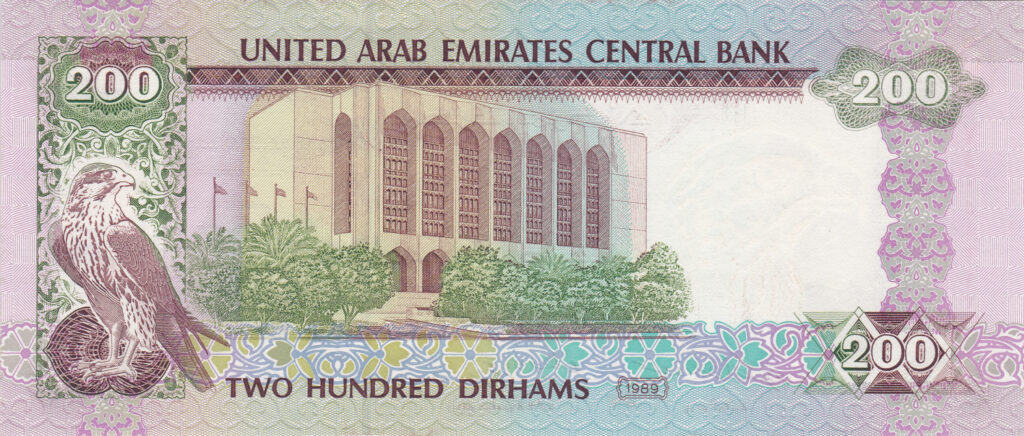
200 dirhams featuring Sharia Court and Zayed Sports City on the front and Falcon and Central Bank on the reverse.
500 dirhams
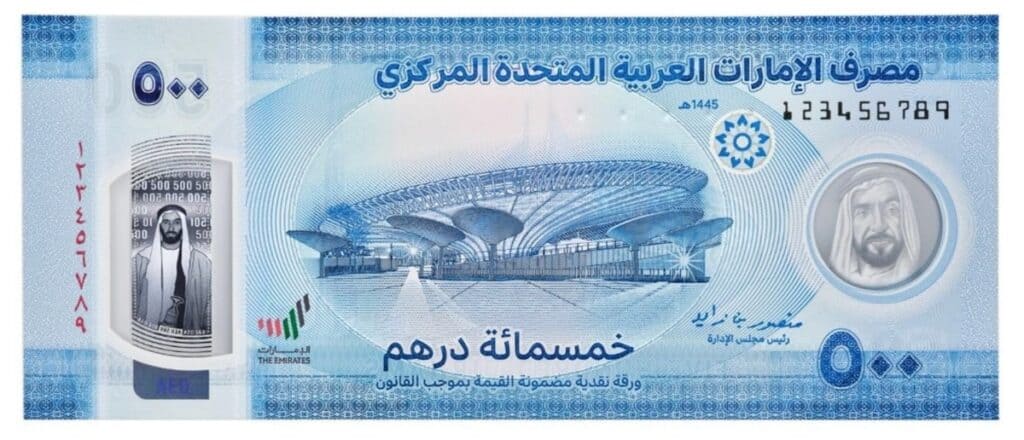
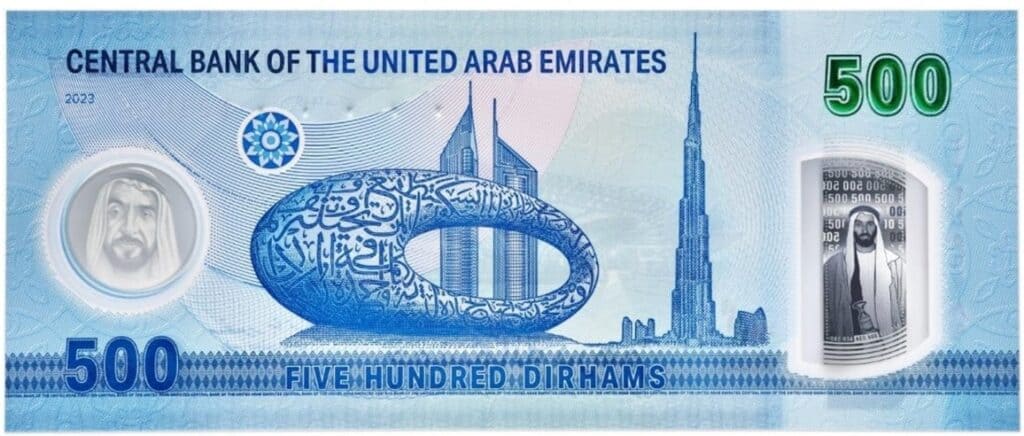
500 dirhams (light blue) featuring the Terra Sustainability Pavilion in Expo Dubai and the Museum of the Future, Emirates Towers, and Burj Khalifa in Dubai
1000 dirhams
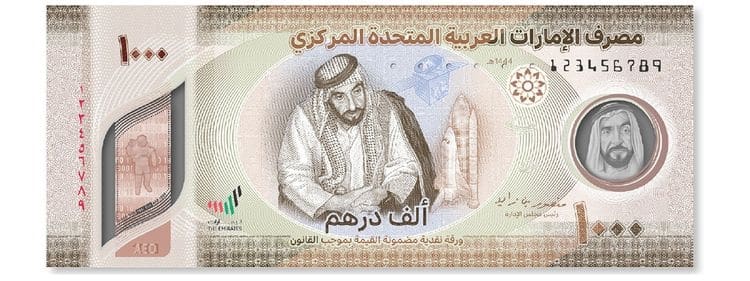
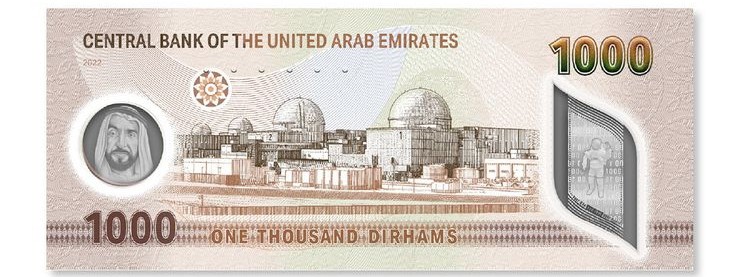
1,000 dirhams (brown) featuring Sheikh Zayed “Hope” probe and the Barakah nuclear power plant in Ruwais.
Currency Usage in Dubai
The official currency of Dubai is the United Arab Emirates dirham (AED), which has been in use since 1973. One dirham is made up of 100 fils. Dirham notes are available in denominations of 5 (brown), 10 (green), 20 (blue/green), 50 (purple), 100 (red), 200 (brown), 500 (navy blue), and 1000 (green/blue) dirhams. Coins come in 1, 25, and 50 fils.
Is USD Accepted in Dubai?
While the official currency of Dubai is the dirham, the US dollar (USD) is widely accepted in most places, especially in tourist areas and major shopping centers. However, it is still recommended to carry dirhams for small transactions and to avoid exchange rate fluctuations.
When exchanging USD to dirhams, it is important to note that exchange rates vary depending on the exchange location. It is recommended to exchange currency at authorized exchange centers such as banks and exchange offices to avoid scams and get the best rates.
Most hotels and restaurants in Dubai accept major credit cards such as Visa, Mastercard, and American Express. It is recommended to check with the establishment beforehand to avoid any inconvenience.
While the official currency of Dubai is the dirham, USD is widely accepted in most places. However, it is still recommended to carry dirhams for small transactions and to exchange currency at authorized exchange centers to avoid scams and get the best rates.
Exchanging Currency in Dubai
If you are traveling to Dubai, you will need to exchange your currency for the local currency, the Emirati Dirham (AED). Exchanging currency can be a confusing process, but with a little knowledge, you can avoid unnecessary fees and get the best exchange rate possible. Here are some insights to help you exchange currency in Dubai.
You can exchange your currency for Dirhams at any of the many exchange bureaus located throughout Dubai and the UAE. You can also exchange currency at international airports, hotels, and banks. It is recommended that you compare exchange rates at different locations to get the best deal.
Credit cards are widely accepted in Dubai, and most major credit cards such as Visa, MasterCard, and American Express are accepted. However, it is always a good idea to carry some cash with you, as some smaller businesses may not accept credit cards.
The United Arab Emirates Dirham is a stable and widely accepted currency in Dubai and the UAE. Familiarizing yourself with the denominations and where to exchange currency will make your travels smoother and more enjoyable.
Where to Exchange Dubai Currency
There are many places where you can exchange Dubai currency, but some offer better rates than others. The best places to exchange currency in Dubai are banks and exchange bureaus. Banks usually offer better rates than exchange bureaus, but they may charge a commission or a fee for the transaction. Exchange bureaus, on the other hand, may not charge a commission or a fee, but their rates may not be as good as a bank’s rates.
There are several places where you can exchange currency in Dubai. Banks and exchange bureaus are the most common places to exchange currency. You can also exchange currency at the airport, but the rates are usually not as good as at a bank or exchange bureau. It’s important to note that some banks and exchange bureaus may have different exchange rates, so it’s a good idea to shop around to find the best rate.
What to Know Before Exchanging Currency
Before you exchange currency in Dubai, there are a few things you should know. First, make sure you know the current exchange rate so you can compare it to the rate you are being offered. Second, be aware of any fees or commissions that may be charged for the transaction. Third, make sure you have a valid form of identification, such as a passport or ID card. Finally, be aware of any scams or frauds that may be common in the area.
Exchanging currency in Dubai can be a simple process if you know what to expect. By doing a little research and shopping around, you can get the best exchange rate possible and avoid unnecessary fees.
Choosing Between USD and Dubai Currency
If you are planning a trip to Dubai, you might be wondering whether you should carry US dollars or the local currency, Emirati Dirham (AED). In this section, we will discuss the pros and cons of each currency to help you make the right choice.
When it comes to choosing between USD and AED, there is no one-size-fits-all answer. It depends on your travel plans and personal preferences. Here are some factors to consider:
Exchange Rate
The exchange rate between your home currency and the UAE Dirham (AED) can impact your budget. It’s important to check the current exchange rate before your trip to get an idea of how much your money is worth in Dubai. You can use online currency converters or check with your bank or exchange service for the latest rates.
Convenience
The most convenient currency to carry in Dubai is the UAE Dirham (AED). It’s accepted everywhere in the city, providing hassle-free transactions for travelers. Although ATMs and currency exchange services are readily available, having AED on hand is ideal for all purchases and services.
Fees
When exchanging currency, be aware of fees and commissions that may be charged. Some banks and exchange services charge a flat fee or a percentage of the transaction amount. It’s important to compare rates and fees to get the best deal. Additionally, some credit cards may charge foreign transaction fees, so it’s important to check with your bank before using your card in Dubai.
Some banks and credit card companies charge transaction fees for foreign currency transactions. If you plan to use your credit card or withdraw money from ATMs, it might be worth checking the fees for both currencies.
Tips
When exchanging currency, check rates and fees for the best deal. Avoid airport exchanges due to potentially higher rates. Use small bills for taxis and small purchases, and opt for credit cards at hotels and restaurants. Keep money secure in a hotel safe, be cautious in public, and avoid carrying large amounts of cash. Consider financial convenience and fees to maximize your Dubai trip without overspending.
Cost of Living in Dubai
If you’re planning to visit or move to Dubai, it’s important to understand the cost of living in the city. Dubai is known for its luxurious lifestyle, which can come with a high price tag. However, with some planning and budgeting, you can enjoy the city without breaking the bank.
Housing is one of the biggest expenses in Dubai. The cost of rent can vary greatly depending on the location and type of accommodation. For example, a one-bedroom apartment in the city center can cost around AED 7,583 per month, while a one-bedroom apartment in the suburbs can cost around AED 2,833 per month. If you’re on a tight budget, consider sharing an apartment with roommates or living in a less expensive area.
Dubai offers a wide range of dining options, from street food to high-end restaurants. The cost of food can vary depending on where and what you eat. If you’re on a tight budget, consider cooking your meals or eating at local restaurants. A meal at a mid-range restaurant can cost around AED 60, while a fast food meal can cost around AED 25.
Dubai has an extensive public transportation system, including buses, trains, and taxis. The cost of transportation can vary depending on the mode of transportation and the distance traveled. A one-way ticket on the metro can cost around AED 7, while a taxi ride can cost around AED 10 per kilometer. If you plan on using public transportation frequently, consider purchasing a Nol card, which offers discounted fares.
Other expenses in Dubai can include entertainment, clothing, and utilities. The cost of these expenses can vary greatly depending on your lifestyle and preferences. If you’re on a tight budget, consider taking advantage of free activities, such as visiting public parks or attending cultural events.
Overall, the cost of living in Dubai can be high, but with some planning and budgeting, you can enjoy the city without breaking the bank.
Don’t Get Scammed Tips
Dubai is known for its luxurious lifestyle, and as a result, it attracts millions of tourists every year. However, with the rise of tourism, there has been a rise in currency scams as well. Here are some tips to help you avoid getting scammed while exchanging currency in Dubai.
1. Choose a Reputable Exchange House
When exchanging currency, always choose a reputable exchange house. Look for exchange houses that are licensed by the Central Bank of the UAE. These exchange houses are regulated and are less likely to scam you. You can also check the exchange rate on the Central Bank of the UAE’s website to ensure that you are getting a fair deal.
2. Avoid Street Exchange
Avoid exchanging currency on the street. Street exchange is illegal in Dubai and is often associated with scams. Stick to licensed exchange houses or banks to ensure that you are getting a fair deal.
3. Check the Exchange Rate
Always check the exchange rate before exchanging currency. Exchange rates can vary from one exchange house to another, so it’s important to shop around. You can also use online currency converters to check the exchange rate.
4. Count Your Money
Always count your money before leaving the exchange house or bank. Make sure that you have received the correct amount and that the notes are not fake. If you are not satisfied, ask the exchange house or bank to count the money in front of you.
5. Beware of Scammers
Beware of scammers who may approach you on the street offering to exchange currency. These scammers often use sleight of hand to trick you into giving them your money. If someone approaches you on the street offering to exchange currency, politely decline and walk away.
By following these tips, you can avoid getting scammed while exchanging currency in Dubai. Remember to always choose a reputable exchange house, avoid street exchange, check the exchange rate, count your money, and beware of scammers.

